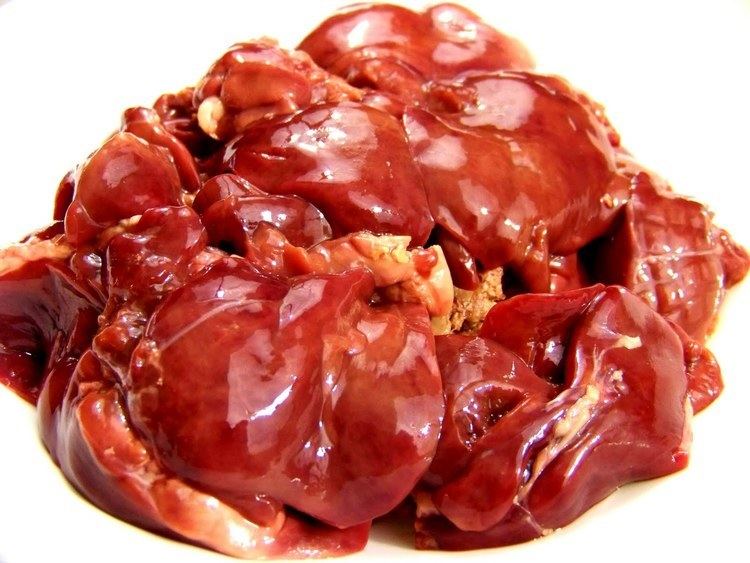Energy 561 kJ (134 kcal) Fat 3.7 g Vitamin A equiv. (813%)6500 μg | Carbohydrates 2.5 g Protein 21 g Riboflavin (B2) (250%)3 mg | |
 | ||
Similar Foie gras, Pâté, Offal, Chicken meat, Beef | ||
The liver of mammals, fowl, and fish is commonly eaten as food by humans. Domestic pig, ox, lamb, calf, chicken, goose, and cod livers are widely available from butchers and supermarkets. Animal livers are rich in iron, copper and preformed vitamin A. 100 g cod liver contains 5 mg of vitamin A and 100 µg of vitamin D.
Contents
Liver can be baked, boiled, broiled, fried, stir-fried, or eaten raw (asbeh nayeh or sawda naye in Lebanese cuisine, liver sashimi). In many preparations, pieces of liver are combined with pieces of meat or kidneys, like in the various forms of Middle Eastern mixed grill (e.g. meurav Yerushalmi). Liver is often made into spreads. Well-known examples include liver pâté, foie gras, chopped liver, and leverpostej. Liver sausages such as Braunschweiger and liverwurst are also a valued meal. Liver sausages may also be used as spreads. A traditional South African delicacy, namely Skilpadjies, is made of minced lamb's liver wrapped in netvet (caul fat), and grilled over an open fire.
Some fish livers are valued as food, especially the stingray liver. It is used to prepare delicacies, such as poached skate liver on toast in England, as well as the beignets de foie de raie and foie de raie en croute in French cuisine. Cod liver (usually tinned in its oil and served seasoned) is a popular spread for bread or toast in several European countries. In Russia, it is served with potatoes. Cod liver oil is commonly used as a dietary supplement.
Poisoning
Very high doses of vitamin A have the potential to be toxic and can cause hypervitaminosis A, a dangerous disorder. There have been several anecdotal reports and a few scientific studies of vitamin A poisoning due to the consumption of the livers of polar bears, walruses, bearded seals, moose, and huskies. The livers of these animals can contain very high levels of vitamin A. The Inuit will not eat the liver of polar bears or bearded seals. It has been estimated that consumption of 500 grams of polar bear liver would result in a toxic dose for a human.
Russian sailor Alexander Konrad, who accompanied explorer Valerian Albanov in a tragic ordeal over the Arctic ice in 1912, wrote about the awful effects of consuming polar bear liver. Also, in 1913, Antarctic explorers on the Far Eastern Party Douglas Mawson and Xavier Mertz were believed to have been poisoned, the latter fatally, from eating husky liver, though this has been contested recently.
Vitamin A poisoning is less likely from consuming oil-based vitamin A products and liver than from consuming water-based and solid preparations.
In 2012 the Government of Nunavut warned pregnant women to avoid eating ringed seal liver due to elevated levels of mercury.
Unrelated to its vitamin content, the liver of the pufferfish (which is consumed in Japanese cuisine as fugu) contains the highest concentration of the neurotoxin tetrodotoxin, which characterizes the species. As a result, it is generally not eaten, and its consumption is tightly regulated by Japanese law.
Traditions
Pig liver is a traditional food in Hawaii. It used to be eaten on New Year's Eve.
